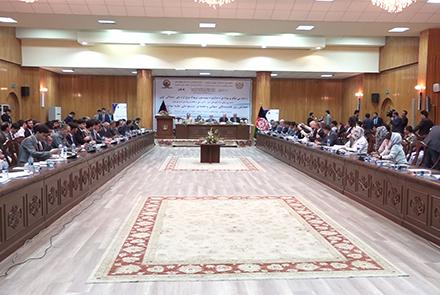Afghanistan annually produces 80 percent of opium used in the world based on fresh statistics given by the Ministry of Counter Narcotics on Monday.
Addressing a gathering on the eve of International Day against Drug Abuse and Illicit Trafficking, Afghan Minister of Counter Narcotics Salamat Azimi said “Afghanistan is world’s largest producer of opium in the world”.
“With the production of more than 80 percent of opium in the world, 2.9 million to 3.6 million people are affected in Afghanistan because of drugs. Based on our current statistics, 11.1 percent of population of the country is affected,” Azimi said.
At same event, Chief Executive Abdullah Abdullah said an increasing insecurity, corruption and instability are among key factors which have been pushing the people to resort on poppy cultivation.
“Insecurity and instability as well as endemic corruption and other social and economic issues have links with poppy cultivation and production,” Abdullah said.
The Afghan government has long been fighting poppy cultivation. Government has been constantly saying that drug production in Afghanistan finances insurgents’ war machine.
Meanwhile, Interior Minister Wais Ahmad Barmak said a significant number of suspects have been arrested recently in connection with drug smuggling cases from across the country.
“We have arrested 1,906 suspects who are in different categories including high-profile drug smugglers and even some elements who been officials of government. I don’t want to name them as they are suspects at the moment. All the individuals are under investigation,” Barmak said.
The United Nations Office on Drugs and Crime (UNODC) estimates the size of the illicit drug market in Afghanistan at up to $7 billion annually.
Talking on the organization’s findings, the UNODC director, Mark Colhoun, said “328,000 hectares of land are under cultivation, 9,000 metric tons of opium produced within a value of estimated 6.6 million dollars which in turn represents nearly 33 percent of Afghanistan’s grass domestic production”.
Statistics by Ministry of Counter Narcotics indicate that over 3.6 million Afghans are addicted to drugs. The figure makes 11.1 percent of the total estimated population in the country.
230 Suspects Arrested In Three Months
The Counter Narcotics Justice Center (CNJC) this week released its quarterly report, saying that 230 suspects, including 13 women and two foreign nationals, were arrested on charges relating to smuggling of drugs, alcohol and illegal chemicals in the first three months of this year.
The report says the center also seized 32 tons of drugs, over 47kg of illegal chemicals and more than 47,000 liters of alcohol.
The CNJC also said the anti-narcotics primary and appeal courts sentenced 179 people, including a woman, to prison after they were found guilty in 136 drug smuggling cases. These culprits all received sentences of between one and 20 years in prison.
According to the report, 91 arrests were made in Kabul and 33 in Nangarhar province. Other arrests were made around the country with the exception of a few provinces including Logar, Daikundi, Nuristan, Panjshir, Wardak, Sar-e-Pul, Paktia, Uruzgan, Kunar, Ghor, Ghazni, Faryab, Bamiyan and Badghis.
The Special Inspector General for Afghanistan Reconstruction (SIGAR) meanwhile said in a recent report that in 2017, poppy cultivation reached a new record high of 328,000 hectares.
In November, US and Afghan forces initiated airstrikes against drug labs in Helmand province, using new authorities included in the South Asia strategy.
The US department of defense described the strikes as the start of a sustained air interdiction campaign to disrupt Taliban financial networks. However, given the ease of setting up drug labs, the campaign’s longer-term impact on narcotics remains uncertain, the report stated.
The report also noted that there is also the risk that air strikes could result in civilian deaths, alienate rural populations, and strengthen the insurgency.


